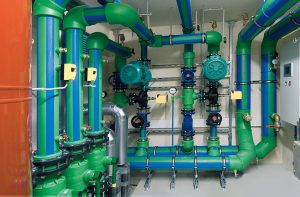Stack vent vs. vent stack
This comes straight from the pages of the ARE and serves as a reminder of the kind of minutiae I tried to memorize just before taking each section of my exams. It’s a classic this or that because they sound similar, look similar in the field and even may combine to serve a similar function. So what’s the difference?
In this corner: a vent stack is series of vertical pipe vents that passes through at least two stories and is meant to maintain atmospheric pressure in the drainage system. The vent stack usually runs parallel with the soil/waste stack and may either extend up through the roof or connect to a stack vent.
And in this corner: a stack vent is the uppermost portion of a soil/waste stack that continues the pipe from above the highest connected fixture out the roof. The stack vent performs a similar function to the vent stack with the biggest difference being the stack vent is a direct extension of the waste/soil stack and must reach outside air.
Still having trouble telling them apart? The names are a big part of the confusion, so if you remember the definitions but not which is which just use the “adjective before noun” rule. So like a “race car” is a car used in races while a “car race” is a race for cars, a “vent stack” is a stack of vents and a “stack vent” is a vent on top of a stack. Also, “race car” is a cool palindrome.
Bonus match: imply vs. infer
To imply is to suggest something without being explicit and to infer is to conclude something by reasoning. Even though imply seems to be on the giving end and infer on the receiving end (“what do you imply by that” vs. “what am I to infer from that”) it’s easy to see how the two words can be used interchangeably since “suggestion” and “conclusion” can be in some cases. Interesting that there is no noun “implier” but there is a matching and more awkward “inferrer”.










